
Videos by ComicBook.com
So far, that’s the only official art we’ve seen from the series…but even just that gives us quite a bit to go on, actually.
We get a look at Telos, the villain at the center of the series, who is in fact Brainiac somehow merged with an as-yet-unidentified world on which he has been collecting bottle cities with samples of universes now extinct.
We also get a look at some of those worlds — and that’s where thing arguably get really interesting.
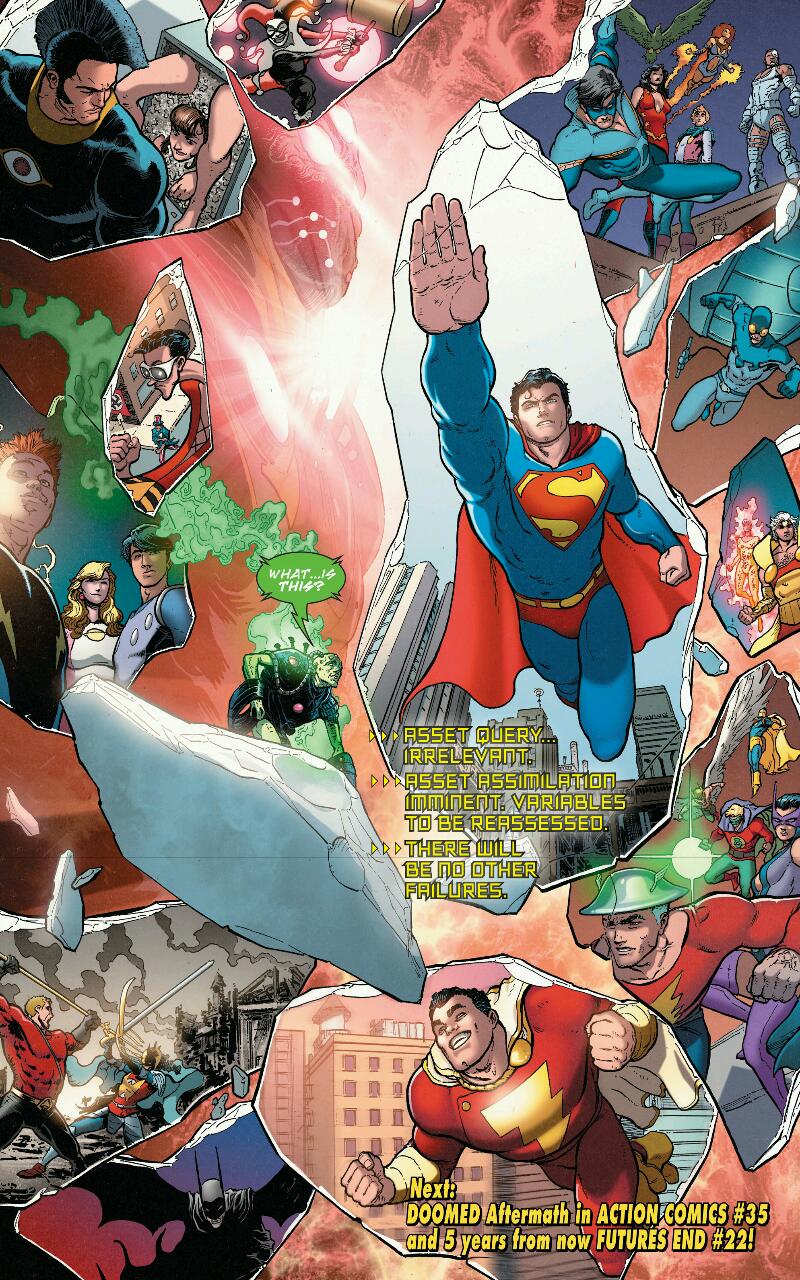
Videos by ComicBook.com
You can see that image at right, and compare it to the Convergence teaser image to see just how similar the “peeks” into the alternate earths are.
One more note before we get started: yes, it does seem that this plan shares some inspiration with what Alexander Luthor was trying to do in Infinite Crisis, merging alternate earths and the like. We’ll see how it plays out and how closely they’re related but remember that Crisis on Infinite Earths is the original element here, and all of the Crisis-type stories since then are a bit derivative anyway, so little things like the bad guy’s endgame being similar isn’t something I’m prepared to indict the writing team for just yet.
First, about Telos: He isn’t the same Blood Moon Brainiac we’ve seen in The New 52: Futures End. He certainly has some elements in common, most notably the odd protrusions coming from his elbows…but it’s a dramatically different design, suggesting that whatever happens to make the jump from Brainiac to Telos likely involves the introduction of some new intelligence to the mix.
Could the planet he’s merging with, then, have an intelligence of its own somehow? Perhaps it’s something akin to Mogo, the Green Lantern who’s a planet?
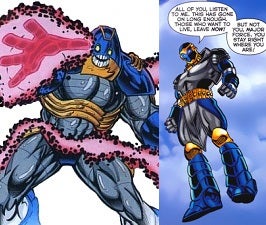
His design — particularly the white, featureless face and bald head — feel somewhat Metamorpho-inspired…but that’s probably just the purple-on-white, which is actually a fairly common motif for Brainiac anyway.
So…what are the worlds we can expect to play a role in this book? First off, let me say that I won’t even attempt to determine which ones they are on the Multiverse map, since according to the announcement, the series will include characters from “various timelines and planets that have ended.” That suggests that their worlds are likely not on the Multiverse map, since that map is made up of worlds that currently exist.

This one appears to be a world where the events of the 1990s didn’t return almost immediately to the pre-Crisis status quo.
We have Azrael-Batman, Steel and Parallax (Hal Jordan) in this image, along with the bearded, hook-handed Aquaman.
Why can we be sure this isn’t just a shot from Zero Hour itself? Well, Batman was back in action by Zero Hour, with Az-Bats having just recently been retired.
Whether Zero Hour, written and drawn by Dan Jurgens, will tie into Convergence #0, co-written by Jurgens, remains to be seen…but it wouldn’t be surprising, since Zero Hour similarly explored dead worlds and anomalies left over from the then-non-existent multiverse.
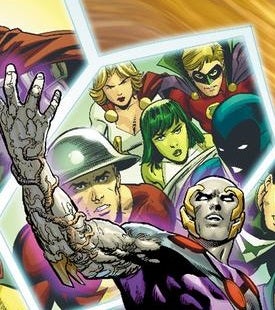
When the DC Multiverse was first introduced with the “Flash of Two Worlds” storyline, the heroes of the ’40s were established to exist on “Earth-2,” a world with similar heroes and villains to our own but with a longer history, and a world where things played out somewhat differently.
Those characters were later integrated into the one earth left standing after Crisis on Infinite Earths, with a modified (Batman- and Superman-less) version of their history serving as inspiration for the heroes of the modern age.
Following the (limited) restoration of DC’s multiverse in Infinite Crisis, the original Earth-2 briefly existed, and then was destroyed. It was never clear whether a modified version of Earth-2 existed prior to the Flashpoint reboot, since DC generally didn’t explore their new multiverse, ostensibly waiting for Grant Morrison to define it with The Multiversity.
When The New 52 launched, we got a new Earth-2, but it was the reverse of the classic Earth-2; it was a modernized take on the DC Universe, rather than a retro one, and it was set in the current day, allowing characters to travel back and forth between the worlds without need for time travel.
One of the main complaints many fans have had about the new Earth-2 is that Infinity, Inc. — the next generation of heroes, inspired by the Justice Society and in some cases actually their children — was missing. As with other legacy heroes written out of the canon at the start of the New 52, this gave the DC Universe a sense of youth at the expense of its history and diversity. However, here we see that Alan Scott’s kids Jade and Obsidian are present…!

The Crime Syndicate of America are a group that has been reinvented as many times as just about any concept in the DC Universe.
Originally headquartered out of Earth-Three, where the superheroes of Earth are villains and they’re battled by the noble Lex Luthor, the group was too good to lose when the Multiverse went away and was reinvented by Grant Morrison in the graphic novel JLA: Earth-2, which explained their existence as the same kind of “pocket universe” that gave us the ’90s Supergirl.
Their designs are periodically reinvented, too, since many of them look a bit silly. We saw their most recent (and close to the classics) incarnation during Geoff Johns’s Forever Evil event, in which they were the antagonists. The Owlman and Johnny Quick costumes make it evident this is the “original” Crime Syndicate, last seen in Crisis on Infinite Earths.

The Charlton heroes, acquired by DC when the publisher folded and introduced into the DC Universe around the time of Crisis, appear in a separate pane here, suggesting a return to the classic Earth-5, where they came from before Crisis folded them into the main DC earth.
The characters were intended to be the stars of Watchmen, but when DC figured out that it would render them essentially unusable in the future, they instead had Alan Moore and Dave Gibbons come up with analogues.
Following the events of 52, a version of the Charlton earth was seen briefly but never returned to (again, waiting for The Multiversity to write the new multiverse rules). Another version is expected in this month’s issue of The Multiversity, titled “Pax Americana,” featuring art by Frank Quitely and apparently a world where the Charlton heroes were the ones who lived through the events of Watchmen.
Captain Atom and Ted Kord’s Blue Beetle both exist — in a very different version — in the New 52 (Ted isn’t a hero at all, and Captain Atom is more akin to his Watchmen counterpart Dr. Manhattan than the action hero seen here). The Question is a cosmic figure who hangs out with the Phantom Stranger and Pandora, rather than a street-level avenger of the night. And the pre-Flashpoint version of Blue Beetle/Ted Kord will begin appearing in Justice League 3000 next month.
So…yeah. These guys get around.
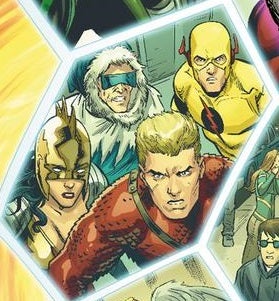
The New 52 was born out of Flashpoint, so this (along with the pre-Flashpoint DC Universe) would be the very last world to have “died” ahead of the restructuring of the multiverse in the reboot.
The heroes of this world were fractured, divided by a deadly worldwide war between Aquaman’s Atlanteans and Wonder Woman’s Amazons. It was created as a result of both The Flash and The Reverse Flash tampering with time with disastrous results, and was repaired, and the New 52 created, only when The Flash and an alternate version of Batman from the Flashpoint universe teamed up to undo the damage The Flash had done to the timeline, condemning his own mother to death in order to save the world (and Bruce Wayne).
This universe was short-lived, but many fans asked in the wake of Flashpoint if we might eventually get stories set in the universe again since the event featured a number of cool concepts that were just barely explored in the few months it existed. It was seen in the animated feature film Justice League: The Flashpoint Paradox.
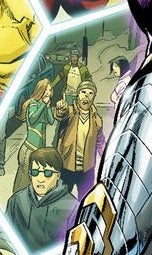
This one could be anything, really, and certainly the women in green and white look like they could be somebody — Fire and Ice, perhaps? — but at the end of the day, there’s nobody clearly recognizable here, and so I have to wonder whether it’s just Earth Prime.
That is, “our” earth. The one on which you’re currently reading an article on ComicBook.com and superheroes are escapist fantasy.
The world popped up in a bunch of Silver and Bronze Age stories, and eventually they did get their first true superhero in the form of Superboy — who grew up reading comics and being taunted for being “Clark Kent,” only to one day discover he really was that Clark Kent. A hero who sacrificed his world to save the universe in Crisis on Infinite Earths, he ultimately found refuge in a pocket universe from which he observed the events of the DC Universe and, unhappy with how they turned out, set about trying to destroy it and rebuild his world in Infinite Crisis. Superboy Prime became a favorite villain for DC Chief Creative Officer Geoff Johns for a while, but hasn’t been seen since shortly before Flashpoint.

One of the most popular Elseworlds in the DC canon, the “Batman & Dracula” trilogy by Doug Moench and Kelley Jones ran through three miniseries — Red Rain, Bloodstorm and Crimson Mist and reinvented Gotham City through the lens of vampire fiction.
Full of cool, trippy visuals, the series have stood the test of time, with DC recently announcing an oversized, black-and-white album edition that shows off Jones’s art.
The concepts have also popped up in the Infinite Crisis video game, and of course there was an animated The Batman Vs. Dracula straight-to-DVD movie, although that didn’t tie into the continuity of these stories.

The WildStorm Universe, originally set at Image Comics and then imported to DC Comics when Jim Lee came over in 1999, was one of the three main worlds folded into the New 52 (along with the Vertigo Universe that included things like Sandman, Hellblazer and the like and the main DC Universe).
Featuring Gen 13 as the “main attraction,” it also included characters like WildC.A.T.S., Team 7 and more. Some of them, including Grifter from WildC.A.T.S. and Caitlin Fairchild from Gen 13, have popped up in The New 52 already.
For some time now, there have been persistent rumors that DC co-publisher Lee hoped to revisit the world of WildC.A.T.S., so don’t be surprised if one of the forty two-issue miniseries features them.
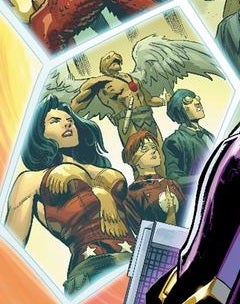
Another Elseworlds tale, this story involves the Justice League of America recast in assorted roles in the Wild West.
This variation on the theme could be interesting, if for no other reason than to see what a number of fairly grounded and earthbound heroes think of the massive cosmic event happening around them — although unless they get their own two-shot, it seems unlikely we’ll get too much of that.
Wonder Woman is a Marshal, Booster Gold is a Maverick-style gambler, Wally West is an outlaw, wrongly accused for the death of Barry Allen.
We also get appearances by Ted Kord, Guy Gardner, Hawkman, Martian Manhunter and Clark Kent by the end.
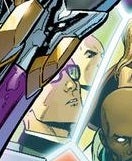
This one gives us almost nothing to work with. It looks like Superman and Lex Luthor, in the style of longtime Superman/Batman artist Ed McGuinness.
The only other thing I can think of is that it’s supposed to be a Superboy story set in Smallville back when they were friends, from one of the timelines where that aspect of their relationship was canon. If that’s the case, it would be another element that was (at least temporarily) wiped out by the Crisis and John Byrne’s post-Crisis Superman reboot The Man of Steel.
Not to belabor the obvious, but the prevalence of Superman characters in these panels coupled with the Daily Planet building in the foreground seems to mark this as a very Superman (or at least Metropolis)-centric event. Could we see the return of the Earth-2 Superman, DC’s true first superhero?

Created by Dan “Zero Hour/Futures End” Jurgens, the Tangent Comics universe was the setting for a series of one-shot comics that ran through two separate events in 1997 and 1998. Written and drawn by a variety of top-tier writers and artists, the concept was to create an interconnected alternate universe that included all of the DC characters — in name only. Superman was a bald, black man who eventually became drunk with power. The Flash was a teen pop star using her light-based powers to court the media. The Green Lantern was a woman with an old Chinese lantern who conjures the spirits of the dead for one last mission. The closest thing they have to a Superman-style hero is The Atom, pictured at top.
Later, they revisited this world in Tangent: Superman’s Reign by Jurgens, a 12-issue maxiseries that looked at the world ten years after the stories were originally published; and then in brief crossovers with Ion and Justice League of America.
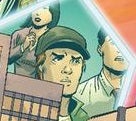
No idea what this world is, but…that looks like Jimmy Olsen in the center of the frame. Like the “Earth Prime” and “Earth-McGuinness” entries above, it’s not clear what, if any, connection this frame has to existing stories or whether they’re just using space that is otherwise obscured to be very general and not commit to any particular Earth that they can’t easily define.
That said…it seems unlikely, right? I mean…an image like this has to have a plan at play.








